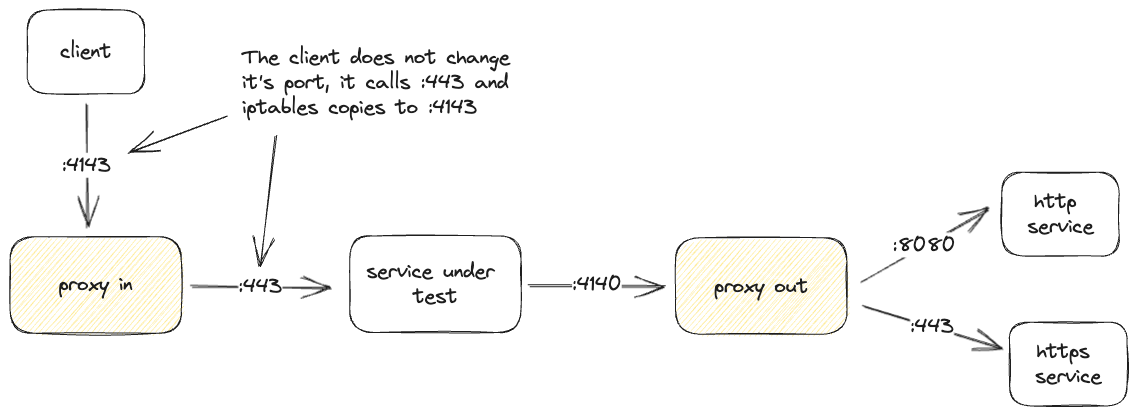Sidecar
In Kubernetes, Speedscale employs a sidecar (also known as goproxy) to capture network level traffic for individual services. The sidecar uses two server sockets to capture traffic:
- Port 4143 - used to capture inbound traffic
- Port 4140 - used to capture outbound traffic
The sidecar or init container uses these ports "intercept" traffic transparently. Here is a basic diagram that shows a client making a call to a service under test, and that service makes subsequent calls to other backend systems. Of course some calls may use an http port like 80 or 8080 (or pick your favorite port), other times the service may use https on port 443 and be using TLS traffic.
 The Speedscale sidecar proxy, goproxy, is
used to collect data from an existing application. To capture
traffic, requests to and from your
application will need to be routed through the proxy.
The Speedscale sidecar proxy, goproxy, is
used to collect data from an existing application. To capture
traffic, requests to and from your
application will need to be routed through the proxy.
Speedscale also supports alternate data collectors including log scraping and even a pre-GA eBPF option (contact support for more information). Envoy WASM plug-ins are not supported because of limitations in the current WASM implementation. WASM plug-ins present limitations for this use case including lack of complete data visibility, lack of support for non-HTTP protocols and a challenging configuration experience.
Bootstrapping Traffic Capture from Speedscale on Vimeo.
The envoy proxy (aka Istio) uses the same architecture to redirect traffic. Your platform or security team may already be familiar with this approach.
Installation
There are several ways to install the sidecar in your cluster. See the proxy configuration reference for proxy configuration outside of a cluster.
- Web App
- Kubernetes Annotation
From the Speedscale web app click on Add service to launch the add service wizard which will walk you through
configuration and verification tailored to your environment.
With cluster access you can add the sidecar with an annotation on your workload.
Please ensure the Kubernetes Operator is running in your cluster before moving on.
Select the workload (daemonset, deployment, statefulset, job or replicaset) you'd like to monitor and add the following annotation:
annotations:
sidecar.speedscale.com/inject: "true"
That's it. Next time you deploy you can check the pods with get pods.
kubectl -n <namespace> get pods
You should notice your container count increases by one and data should be flowing.
NAME READY STATUS RESTARTS AGE
carts-xxxxxxxxxx-xxxxx 2/2 Running 0 38d
By default, the Speedscale init container starts after any existing init containers in the workload.
Removal
If you already have the sidecar installed, but you need for it to be removed,
you may either set the sidecar.speedscale.com/inject annotation to false,
or remove it:
annotations:
sidecar.speedscale.com/inject: "false"
After deploying or patching your deployment, you should notice your container count decrease by one and the sidecar is no longer attached.
Use speedctl uninstall to remove all Speedscale components.
Permissions
When deploying the Speedscale sidecar and its init container, certain Kubernetes permissions are required to ensure proper functionality. Below are the permissions needed for both the init container and the sidecar.
Sidecar Permissions
The sidecar itself requires the following permissions:
securityContext:
allowPrivilegeEscalation: false
capabilities:
add:
- NET_RAW
- NET_ADMIN
privileged: false
runAsNonRoot: false
runAsUser: 0
Init Container Permissions
The init container requires the following security context settings:
securityContext:
allowPrivilegeEscalation: false
capabilities:
add:
- NET_RAW
- NET_ADMIN
privileged: false
runAsNonRoot: false
runAsUser: 0
Cluster RBAC
You can find the cluster RBAC settings by looking at the latest version of the Speedscale helm chart in this file /operator-helm/charts/<version>/templates/rbac.yaml. The location of this file changes based on the version you are using but here is an example of the file for version 2.3.636.